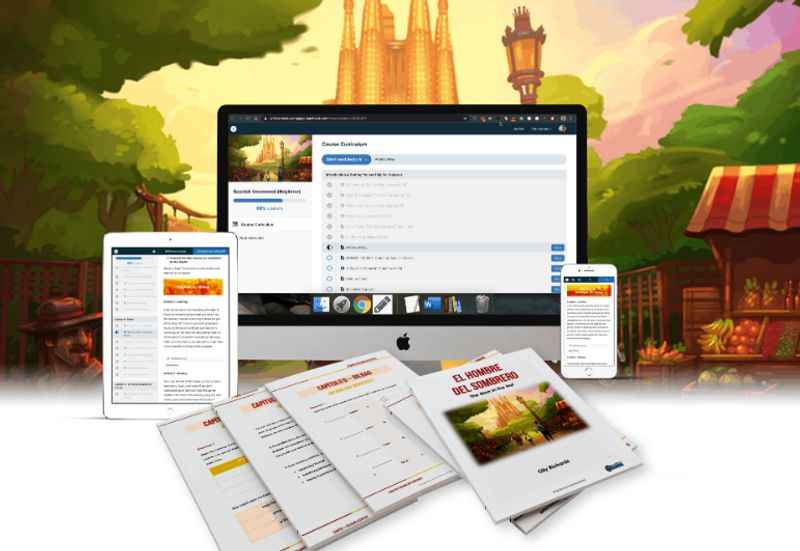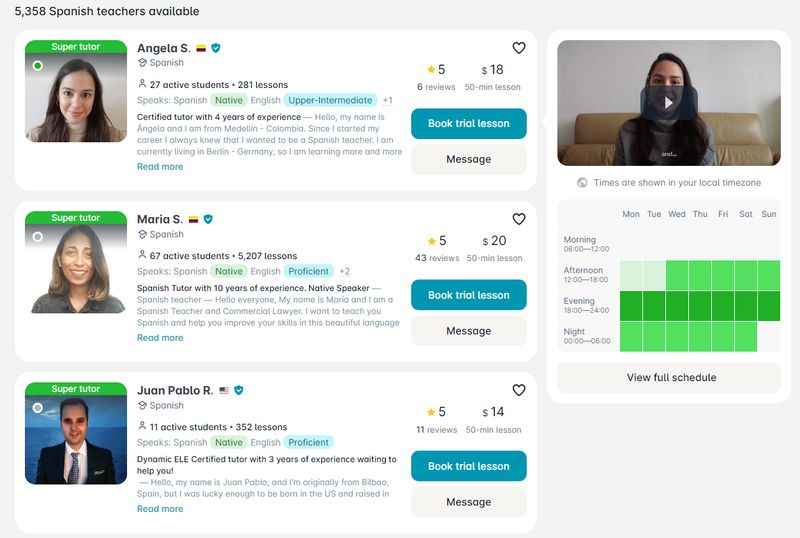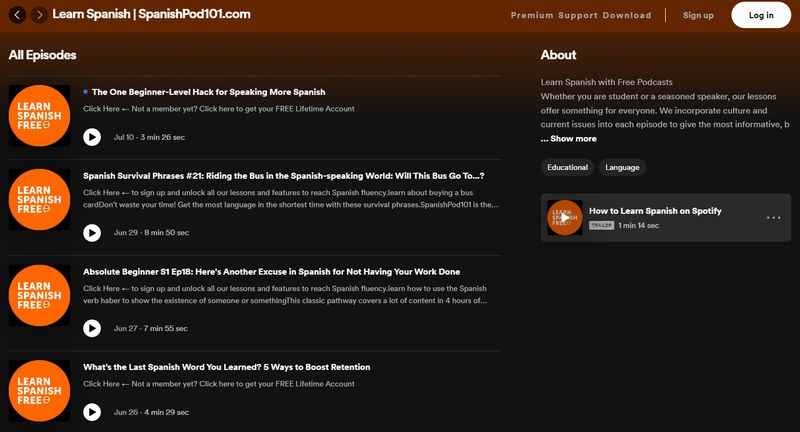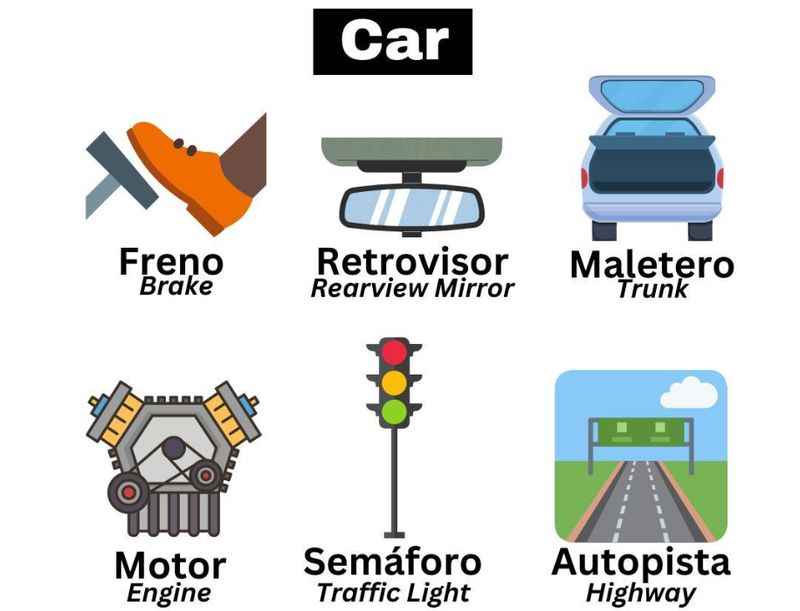18 Ways to Learn Conversational Spanish for Travel | 2024

Are you planning a trip to a Spanish-speaking country?
Imagine exploring UNESCO World Heritage sites, strolling through cobblestone streets, and basking on white sand beaches while engaging in vibrant conversations with native speakers.
In this guide, we will unveil the secrets to learning conversational Spanish for your travel adventure.
From the charming towns of Southern Spain to the captivating landscapes of South America, we'll equip you with essential vocabulary, grammar rules, and useful phrases to speak Spanish fluently in real-life situations.
Whether you're visiting the Andes Mountains or the Caribbean coast, get ready to unlock a world of culture, history, and spectacular views.
With a little bit of help, you will learn conversational Spanish in no time.
1. Watch Spanish TV Shows to Improve Your Language Skills

Watching Spanish TV shows is a fantastic way to enhance your language skills while enjoying the comfort of your living room.
By immersing yourself in authentic Spanish content, you can improve your listening comprehension, expand your key vocabulary, and familiarize yourself with colloquial expressions.
From captivating telenovelas to informative documentaries, Spanish TV offers a diverse range of programming to cater to every interest.
Explore popular shows from Spain, delve into the vibrant culture of Latin America, or discover hidden gems from North Africa and its Spanish-speaking regions.
Immerse yourself in famous series that showcase the richness of the language and culture. So grab your popcorn, sit back, and let your living room become the perfect place to learn conversational Spanish.
Your living room is the perfect place to learn conversational Spanish.
2. Sign Up to Spanish Uncovered for Fun and Interactive Spanish Learning

Spanish Uncovered is the Spanish course we recommend you use to learn conversational Spanish quickly through proven learning methods.
It is a language course that offers a unique, independent approach to learning the Spanish language.
The course is part of the ‘Uncovered' series which offers you the chance to learn a new language through an entire story.
Comprising 20 modules, Spanish Uncovered claims to take you to an upper-intermediate level of Spanish within 100-150 hours of study time.
The Spanish story, El Hombre del Sombrero, contains an easy narrative with basic grammar and common Spanish vocabulary words.
This course, unlike many alternative language learning courses, provides you with material and common Spanish phrases that you'll actually use in your everyday life.
Spanish Uncovered is best for those at the early stages of language learning or those with limited knowledge of Spanish to begin with. You can sign up for free via the link below.
3. Find an Online Teacher for Personalized Spanish Lessons

For a personalized and tailored approach to learning Spanish, consider connecting with an online teacher. An online teacher offers the advantage of one-on-one instruction, allowing you to receive individual attention and customized lessons.
By working with an online teacher, you can focus on your specific language needs, whether it's improving your conversational skills, refining your pronunciation, or tackling challenging grammar concepts.
These personalized lessons provide invaluable feedback, guidance, and support, accelerating your language learning journey.
With the convenience of online platforms like Fiverr, you can easily find and connect with qualified teachers who can help you reach your Spanish fluency goals.
So, take advantage of personalized Spanish lessons from the comfort of your own home and watch your language skills soar.
4. Travel to a Spanish-Speaking Country for Total Immersion

Traveling to a Spanish-speaking country offers an unparalleled opportunity for total immersion in the language and culture.
Whether you choose to explore the vibrant cities of Spain, such as Madrid, Barcelona, or San Sebastian, or venture to South America's popular destinations like Buenos Aires in Argentina or Lima in Peru, each location presents a unique experience.
Immerse yourself in the rich history of Spain's cobblestone streets, indulge in the culinary delights of the Basque Country, or relax on the white sand beaches of the Costa del Sol.
From the stunning landscapes of Patagonia in Chilean territory to the captivating beauty of Tayrona National Park in Colombia, these countries provide the perfect backdrop for enhancing your Spanish skills while creating lifelong memories.
By engaging with locals, navigating real-life situations, and embracing the everyday language, you'll develop a deeper understanding of Spanish and truly immerse yourself in the vibrant tapestry of the Spanish-speaking world.
5. Practice Speaking with Native Speakers to Master Conversational Spanish

To master conversational Spanish, there's no substitute for practicing with native speakers.
Engaging in conversations with locals provides an immersive and invaluable experience that accelerates your language-learning journey.
Striking up conversations with native speakers allows you to apply your learning in real-life situations.
The best places to visit tend to be places where fewer people speak English so you'll have ample opportunities to converse with locals and immerse yourself in the local culture.
That being said, you may want to start your exploration in the major cities guided by a Spain travel guide so you can develop an understanding of the culture.
And don't limit yourself to Spain alone. All across the world, you'll find captivating capitals, charming towns, and diverse regions where you can practice conversational Spanish.
So, seize every chance to engage with native speakers, ask for local recommendations, and embrace the linguistic richness of the Spanish language to unlock a world of communication and connection.
6. Dedicate Daily Time to Studying Spanish Vocabulary for Consistent Progress

Consistency is key when it comes to learning Spanish vocabulary. By setting aside dedicated time each day, you can make steady progress in expanding your language skills.
Whether it's through flashcards, vocabulary lists, or online resources, make a habit of actively engaging with new words and expressions.
By committing to daily study sessions, you'll reinforce your memory, improve retention, and build a solid foundation of Spanish vocabulary.
So, carve out a specific time each day, create a study routine, and watch your language proficiency grow steadily as you embrace the power of consistent learning.
7. Listen to Spanish Music and Sing Along to Enhance Your Pronunciation

Music is a powerful tool for improving your Spanish pronunciation and accent.
By listening to Spanish music and singing along, you can train your ears to recognize the sounds, rhythms, and intonations of the language.
Explore various genres such as salsa, flamenco, or reggaeton, and immerse yourself in the captivating lyrics. Pay attention to the pronunciation of words and mimic the singers to enhance your own vocal skills.
By incorporating music into your language learning journey, you'll not only have fun but also develop a more authentic and natural Spanish accent.
8. Use Flashcards to Expand Your Vocabulary

Expand your Spanish vocabulary by utilizing flashcards, which can be made yourself or found on some language-learning apps.
Flashcards are a tried-and-true method for memorizing new words, enabling you to practice anytime, anywhere. Pair them with mnemonic devices or visuals to aid memorization.
Additionally, language-learning apps offer a convenient way to access a wide range of vocabulary exercises, interactive games, and quizzes.
Explore popular apps to reinforce your learning and discover new words and phrases.
With the help of flashcards and apps, you'll expand your vocabulary repertoire, improve your language fluency, and gain confidence in your Spanish communication skills.
9. Find a Language Partner for a Valuable Language Exchange Experience

Enhance your Spanish skills by finding a language partner for a valuable language exchange.
Connect with native Spanish speakers who are learning your native language, and together, embark on a rewarding language journey.
Immerse yourself in meaningful conversations, exchange cultural insights, and practice your language skills in real-life contexts.
Whether you meet in person or engage online, this language exchange experience offers a unique opportunity to improve your fluency, expand your vocabulary, and gain cultural understanding.
10. Read Spanish Books, Newspapers, and Magazines for Contextual Learning

Immerse yourself in the beauty of the Spanish language and culture by reading Spanish books, newspapers, and magazines.
Dive into captivating novels, explore informative articles, and discover the latest news.
Reading provides context and exposes you to different writing styles, vocabulary, and grammar structures. Immerse yourself in the stories of old towns around Latin America, bustling cities in Mexico, and the vibrant culture of the Iberian Peninsula.
From quaint Andean villages to the vibrant cities at sea level in Colombia, reading materials offer a window into the diverse landscapes and cultures of the Hispanic world.
So, grab a book, pick up a newspaper, or explore online magazines, and let the words transport you to the enchanting world of Spanish language and literature.
11. Utilize Language Learning Podcasts for Improved Spanish Fluency

Boost your Spanish fluency by incorporating language learning podcasts into your routine. Podcasts provide an engaging and convenient way to immerse yourself in authentic Spanish conversations and improve your listening comprehension.
Explore podcasts that cover a range of topics, from travel tales featuring famous landmarks to discussions about art galleries and cultural events in big cities around the Spanish-speaking world.
Listening to podcasts allows you to learn at your own pace while developing an ear for native pronunciation and gaining exposure to the diverse accents of the Hispanic world.
12. Attend Language Meetups and Events to Immerse Yourself in Spanish Culture

Immerse yourself in Spanish culture and language by attending language meetups and events.
These gatherings provide an ideal setting to practice your conversational skills, connect with fellow language enthusiasts, and gain insights into the rich cultures of Spanish-speaking countries.
Whether it's a general language meetup in your city or an event focused on a specific theme like art, music, or gastronomy, you'll find yourself surrounded by like-minded individuals eager to share their language and cultural experiences.
13. Engage in Daily Conversations with Spanish-Speaking Friends for Practice

Take advantage of the opportunity to practice your Spanish skills by engaging in daily conversations with Spanish-speaking friends. Meaningful interactions with native speakers are invaluable.
Whether they are friends from a language school, a language meetup, or work, conversing regularly with friends allows you to apply your learning, improve your fluency, and gain confidence in your conversational Spanish.
Embrace the cultural richness of South America, discuss the best places to visit, and explore the fascinating stories behind landmarks like the Recoleta Cemetery in Buenos Aires or the enchanting old towns found throughout the continent.
14. Join Spanish Language Forums and Communities for Online Resources

Expand your Spanish language resources by joining online forums and communities dedicated to learning and practicing Spanish.
These platforms provide a wealth of information, language tips, and opportunities to engage with fellow language enthusiasts.
Connect with learners from around the world who share your passion for learning conversational Spanish. Explore topics related to South America, including its rich culture, cuisine, and landmarks like Angel Falls.
Interact with members, ask questions, and exchange language-learning strategies.
Through these online communities, you'll discover valuable resources, receive guidance, and foster a supportive learning environment.
15. Engage in Spanish-Language Games and Quizzes for Playful Learning

Make learning Spanish a playful and enjoyable experience by engaging in language games and quizzes. Explore interactive platforms that offer a wide range of games designed to enhance your language skills.
From vocabulary challenges to grammar quizzes, these games provide a fun and engaging way to reinforce your knowledge while immersing yourself in the language.
By incorporating playful learning strategies, you'll stay motivated and make steady progress in your journey to learn conversational Spanish.
16. Explore Online Courses and Tutorials for Spanish

Unleash the potential of online courses and tutorials to deepen your understanding of the Spanish language. Language-learning websites offer comprehensive resources, structured courses, and tutorials tailored to various proficiency levels.
Explore courses that cover South American culture, uncover the secrets of the best places to visit there, and delve into the rich history of the native people.
With a variety of interactive exercises, audiovisual materials, and quizzes, these online resources provide a flexible and self-paced learning experience.
17. Set Achievable Goals and Track Your Progress to Stay Motivated

Stay motivated on your journey of learning conversational Spanish by setting achievable goals and tracking your progress.
Define specific objectives, such as mastering certain vocabulary or improving your speaking skills, and break them down into smaller, manageable tasks.
Progress tracking allows you to see how far you've come. Celebrate each milestone and use it as fuel to keep pushing forward on your language learning course.
With a clear direction and measurable progress, you'll maintain motivation and achieve your desired fluency level.
18. Embrace Mistakes and Keep Practicing Spanish Fearlessly

Don't let the fear of making mistakes hold you back from practicing Spanish. Embrace errors as an integral part of the learning process.
Each mistake is an opportunity to grow and refine your language skills.
Whether you're conversing with locals in South America or asking a Spaniard how to get to a famous landmark, approach every interaction fearlessly.
Learn from your mistakes, seek feedback, and keep practicing. Remember that language learning is a journey, and every misstep brings you closer to fluency.
So, step out of your comfort zone, embrace challenges, and let your fearless pursuit of improvement guide you toward mastering conversational Spanish in South America.
FAQs About How to Learn Conversational Spanish for Travel
Now that you know a few ways to learn conversational Spanish let's check out some of the most frequently asked questions on this subject.
Can you explore UNESCO World Heritage Sites in Spain without knowing Spanish too well?
While knowing some Spanish would enhance your experience, it's still possible to explore UNESCO World Heritage Sites in Spain without fluency. Many sites have multilingual information, and English is often spoken in tourist areas.
However, learning basic Spanish phrases can greatly enrich your interactions and understanding of the culture during your visit.
Some famous UNESCO World Heritage Sites in Spain include:
- Alhambra, Generalife, and Albayzín, Granada
- Historic Center of Cordoba
- Works of Antoni Gaudí (including Park Güell, Palau Güell, Casa Milà, Casa Vicens, Gaudí's Crypt in Colònia Güell, Casa Batlló, and Sagrada Familia), Barcelona
How long does it take to learn to speak Spanish fluently?
The time it takes to become fluent in Spanish varies based on factors such as your prior language experience, dedication, and immersion. Generally, it can take around 600-750 hours of study and practice to reach a conversational level.
Fluency, which depends on your goals and proficiency, typically requires several years of consistent learning and immersion.
Is southern Spain welcoming to expats?
Southern Spain, known for its vibrant culture and warm climate, is generally welcoming to expats. Popular cities like Seville and Malaga have established international communities and amenities to support expatriates.
Locals are often friendly and open to cultural exchange, making it easier to integrate into the local community and enjoy your time in southern Spain.
What languages should I learn in order to travel across Europe?
English is widely spoken in many European countries and can suffice for basic communication. However, learning key phrases in the local languages of the countries you plan to visit, such as Spanish in Spain or French in France, shows respect and enhances your travel experience.
Additionally, having a basic understanding of languages like German or Italian can be beneficial in certain regions.
Summing Up: How to Learn Conversational Spanish for Travel
Congratulations! You've embarked on a journey to master conversational Spanish and unlock a wealth of unforgettable travel experiences.
Armed with your newfound language skills, you can now navigate the enchanting cities of Spain, explore the wonders of South America, and immerse yourself in the vibrant cultures of Latin America.
From the architectural marvels of Barcelona's Gothic Quarter to the majestic Iguazu Falls, you'll feel confident engaging with locals and discovering hidden gems.
So pack your bags, dive into the rich history of Spanish royalty, and let the beauty of the language guide you as you embark on your next thrilling trip. ¡Buen viaje!







